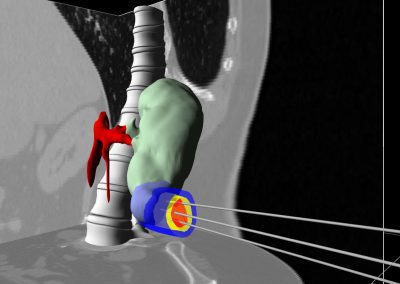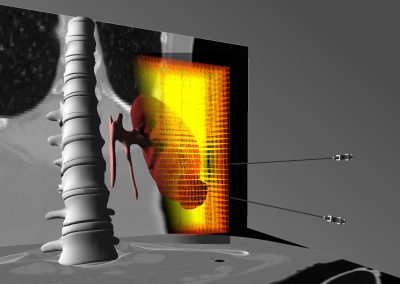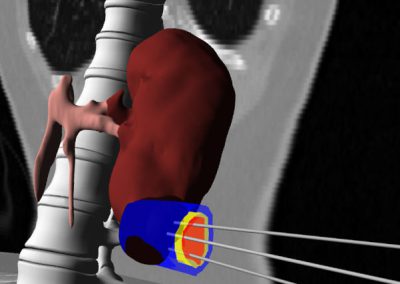In interventional radiology, cryoablation is a growing technique for tumor ablation.
Method: Several hollow needles are percutaneously inserted in the target area under image guidance and a gas (usually argon) is then de-compressed inside the needles. Based on the Thompson-Joule principle, the temperature drops drown and a ball of ice crystals forms around the tip of each needle. Radiologists rely on the geometry of this iceball (273~K), visible on computer tomography (CT) or magnetic resonance (MR) images, to assess the status of the ablation.
However, cellular death only occurs when the temperature falls below 233~K. A key to the success of cryotherapy is the planning of the position and orientation of the multiple probes required to treat a tumor, while avoiding critical damage to the surrounding tissues. The therapy planning therefore, strongly depends on the experience of the clinician.
Currently, commercial systems are nearly non existent, and emerging tools are limited to a visualization of the isotherms obtained for each probe in ideal conditions (usually in a gel). They do not account for any influence of the soft tissue properties, the presence of blood vessels, or the combined effect of multiple probes.
In 2012, one of the leading expert in cryoablation Prof. Afshin Gangi asked for the development of new innovative tools, taking into account this synergistic effect. Since the cardiac electrophysiology equation (see associated project) and the heat transfer equation of Pennes are similar (both diffusion-reaction equations), we rapidly built a first simulation of heat transfer based on a tetrahedral approach. Using a marching cube algorithm, it is then possible to determine the isotherms in the simulation. Later and with the help of a student, we worked on the optimization of the needle placement. We implemented a hybrid algorithm using a combination of a genetic algorithm and a bubble packing. By using both a stochastic and a geometric method yielded to more very promising results.



